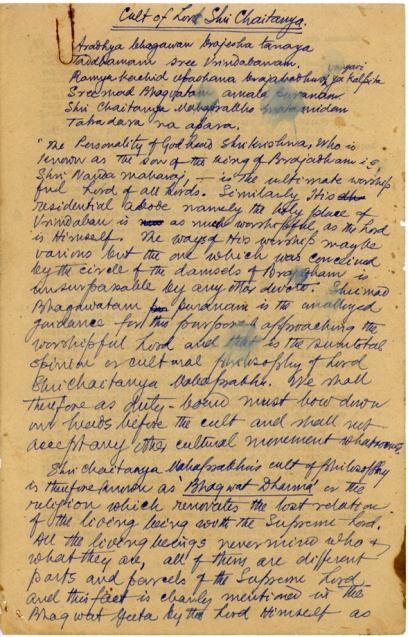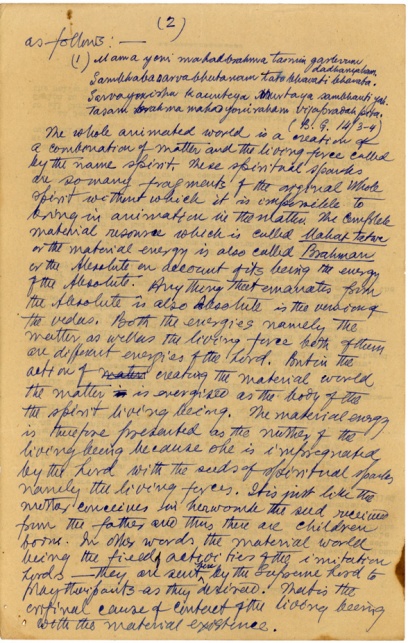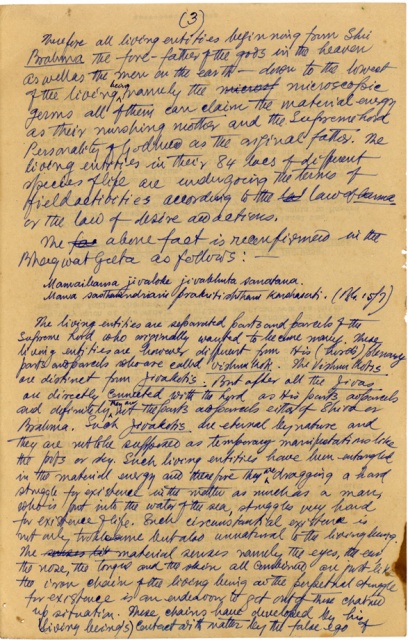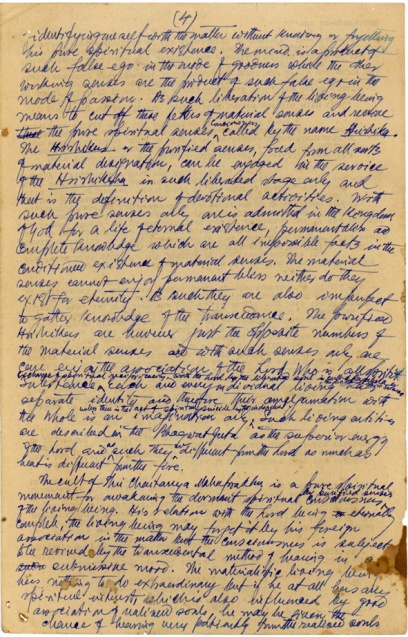Cult of Lord Shri Chaitanya
(This has been proofread against the original handwritten manuscript. and spelling changes have been made for the Bhaktivedanta VedaBase.—Ed. Bhaktivedanta Archives)




Cult of Lord Shri Chaitanya
- ārādhyo bhagavān vrajeśa tanayas tad dhāma śrī vrṇdāvanam
- ramyā kācid upāsanā vrajavadhū vargeṇa vā kalpitā
- śrīmad-bhāgavatam amalaṁ purāṇaṁ
- śrī-caitanya mahāprabhor matam idaṁ tatrādarāḥ na paraḥ
The Personality of Godhead Śrī Krishna, Who is known as the son of the King of Vrajadhāma i.e. Śrī Nanda Mahārajā, is the ultimate worshipful Lord of all Lords. Similarly His residential abode namely the holy place of Vṛndāvana is as much worshipful as the Lord is Himself. The ways of His worship maybe various but the one which was conceived by the circle of the damsels of Vrajadhāma is unsurpassable by any other devotee. Śrīmad-Bhāgavatam Purāṇam is the unalloyed guidance for this purpose of approaching the worshipful Lord and that is the sum total opinion or cultural philosophy of Lord Śrī Caitanya Mahāprabhu. We shall therefore as duty-bound must bow down our heads before the cult and shall not accept any other cultural movement whatsoever.
Śrī Caitanya Mahāprabhu's cult of philosophy is therefore known as bhāgavata-dharma or the religion which renovates the lost relation of the living being with the Supreme Lord. All the living beings never mind who and what they are, all of them are different parts and parcels of the Surpeme Lord and this fact is clearly mentioned in the Bhagavad-gītā by the Lord Himself as follows:
- mama yonir mahad brahma
- tasmin garbhaṁ dadhāmy aham
- sambhavaḥ sarva bhūtānāṁ
- tato bhavati bhārata
- sarva-yoniṣu kaunteya
- mūrtayaḥ sambhavanti yāḥ
- tāsāṁ brahma mahad yonir
- ahaṁ bīja-pradaḥ pitā
- (14.3-4)
The whole animated world is a creation of a combination of matter and the living force called by the name spirit. These spiritual sparks are so many fragments of the original Whole spirit without which it is impossible to bring in animation in the matter. The complete material resource which is called mahat-tattva or the material energy is also called Brahman or the Absolute on account of its being the energy of the Absolute. Anything that emanates from the Absolute is also Absolute is the version of the Vedas. Both the energies namely the matter as well as the living force both of them are different energies of the Lord. But in the action of creating the material world the matter is energised as the body of the the spirit living being. The material energy is therefore presented as the mother of the living being because she is impregnated by the Lord with the seeds of spiritual sparks namely the living forces. It is just like the mother conceives in her womb the seed received from the father and thus there are children born. In other words the material world being the field of activities of the imitation Lords—they are sent here by the Supreme Lord to play their parts as they desired. That is the original cause of contact of the living being with the material existence.
Therefore all living entities beginning from Śrī Brahma the fore-father of the gods in the heaven as well as the men on the earth down to the lowest of the living being namely the microscopic germs all of them can claim the material energy as their nursing mother and the Supreme Lord Personality of Godhead as the original father. The living entities in their 84 lakhs of different species of life are undergoing the terms of field activities according to the law of karma or the law of desire and actions.
The above fact is reconfirmed in the Bhagavad-gītā as follows:
- mamaivāṁśo jīva-loke
- jīva-bhūtaḥ sanātanaḥ
- Manaḥ ṣaṣṭhānīndriyāṇi
- prakṛti-sthāni karṣati
- (BG 15.7)
The living entities are separated parts and parcels of the Supreme Lord who originally wanted to become many. These living entities are however different from His (the Lord's) plenary parts and parcels who are called viṣṇu-koṭi. The viṣṇu-koṭis are distinct from jīva-koṭis. But after all the jīvas are directly connected with the Lord as His parts and parcels and definitely they are not the parts and parcels either of Śiva or Brahmā. Such jīva-koṭis are eternal by nature and they are not to be supposed as temporary manifestations like the pots or sky. Such living entities have been entangled in the material energy and therefore they are dragging a hard struggle for existence in the matter as much as a man who is put into the water of the sea, struggles very hard for existence of life. Such circumstantial existence is not only troublesome but also unnatural to the living being. The material senses namely the eyes, the ear, the nose, the tongue and the skin all combined are just like the iron chain of the living being and the perpetual struggle for existence is an endeavor to get out of these chained up situation. These chains have developed by his (the living being's ) contact with matter by the false ego of identifying one self with the matter without knowing or forgetting his pure spiritual existence. The mind is a product of such false ego in the mode of goodness while the other working senses are the product of such false ego in the mode of passion. As such liberation of the living being means to cut off these fetters of material senses and revive the pure spiritual senses consciousness called by the name hṛṣīka. The hṛṣīkas or the purified senses, freed from all sorts of material designation, can be engaged in the service of the Hṛṣīkeśa in such liberated stage only and that is the definition of devotional activities. With such pure senses only one is admitted in the Kingdom of God for a life of eternal existence, permanent bliss and complete knowledge which are all impossible facts in the conditioned existence of material senses. The material senses cannot enjoy permanent bliss neither do they exist for eternity. As such they are also imperfect to gather knowledge of the transcendance. The purified hṛṣīkas are however just the opposite numbers of the material senses and with such senses only one can enjoy the association of the Lord Who is all spirit substance. Exchange of spiritual reciprocity with the Lord by the liberated soul is called rasalīlā or the display of spirit (indistinct). Each and every individual living has separate identity and therefore their amalgamation with the whole is an imagination only unless there is the act of spiritual suicide by the individual. Such living entities are described in the Bhagavad-gītā as the superior energy of the Lord and as such they are different from the Lord as much as heat is different from the fire.
The cult of Śrī Caitanya Mahāprabhu is a pure spiritual movement for awakening the dormant spiritual consciousness by purified senses of the living being. His relation with the Lord being eternally complete, the living being may forget it by his foreign association in the matter but the consciousness is subject to be revived by the transcendental method of hearing in a submissive mood. The materialistic living being has nothing to do extraordinary but if he at all has any spiritual interest, which is also influenced by good association of realised souls, he may be given the chance of hearing very patiently from the realised souls ... (REST MISSING)